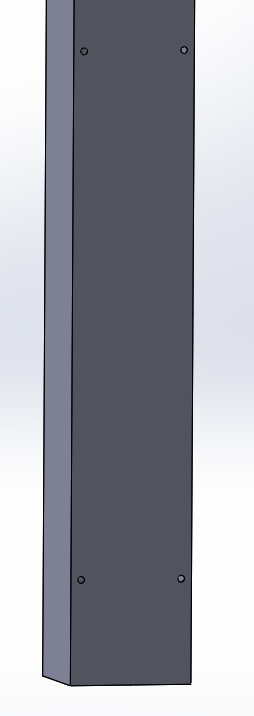abautis
Mechanical
- Jan 27, 2016
- 4
Hello,
I have concern regarding a hollow steel structural column that has recently been altered. At 4 separate height sections (all of which are separated by about 3 ft from the bottom), 3/8" through holes have been drilled through two given parallel faces. There are two holes at a given cross section, separated at roughly 3.5 inches apart (center to center). The hollow column itself is 7" x 7", with a 1/8" thickness. The column itself is between 70-80 ft tall and helps support the roof. I have included an image to give you an idea of what I am describing. Yes, it would be best if these holes were non-existent.
With an assumed factor of safety of 4 for structural steel construction ( at a given cross section of the column, taking into consideration compression loading (F/A), a new factor of safety was calculated at the new weakest given cross section. This cross section is the point where the entire diameter of each hole (2) has been removed from the given uniform square cross section. This new factor of safety was calculated to be 3.6. We have not included buckling within this calculation, as we do not see buckling being an issue at the hole location given how close to the bottom of the column they are.
I am curious if this is something to be concerned about. We have plans on welding these holes closed later. Thanks!

I have concern regarding a hollow steel structural column that has recently been altered. At 4 separate height sections (all of which are separated by about 3 ft from the bottom), 3/8" through holes have been drilled through two given parallel faces. There are two holes at a given cross section, separated at roughly 3.5 inches apart (center to center). The hollow column itself is 7" x 7", with a 1/8" thickness. The column itself is between 70-80 ft tall and helps support the roof. I have included an image to give you an idea of what I am describing. Yes, it would be best if these holes were non-existent.
With an assumed factor of safety of 4 for structural steel construction ( at a given cross section of the column, taking into consideration compression loading (F/A), a new factor of safety was calculated at the new weakest given cross section. This cross section is the point where the entire diameter of each hole (2) has been removed from the given uniform square cross section. This new factor of safety was calculated to be 3.6. We have not included buckling within this calculation, as we do not see buckling being an issue at the hole location given how close to the bottom of the column they are.
I am curious if this is something to be concerned about. We have plans on welding these holes closed later. Thanks!

